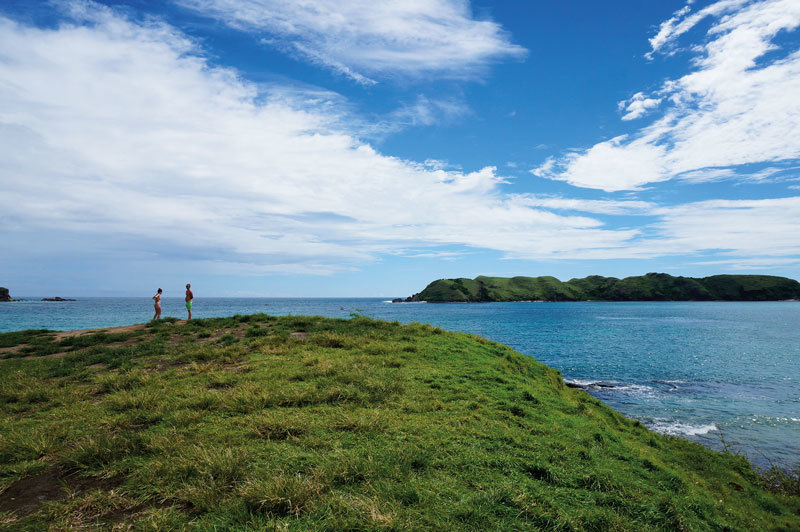There’s no doubt that Bali is the most popular island destination in Indonesia, but those ventur-ing east to the neighbouring Lombok will find equally enchanting beaches, surf, and culture. The warmth of the sun, a good book to read and a cold drink in hand, my sailing trip to the island east of Bali was filled with warm breezes and a sunny day.

Travel brochures advertise Lombok as “the way Bali was 20 years ago,” in theory untouched and unspoiled. I remember arriving in Lombok two years ago at Teluk Kodek, an area in the northern part of the island surrounded by swaying palm trees and sleepy villages. I took the scenic route down to the touristic Senggigi, entertained by the bird’s eye view of the lining beaches below, passing beachfront empty lands with signboards saying “For Sale” as I approached Senggigi.
Last month, I arrived at the same spot, noticing that some parts of the natural sandy floor just steps away from the jetty had been layered with paving blocks, making it easy for motorbikes and cars to access the small seaport. Obviously things have changed since the last time I visited the island; so I could only wonder what had happened to those empty lands on the way to Senggigi.
But I decided to not go the same road as last time, and instead made my first Lombok stop at a traditional market in Medana, near the area called Tanjung, eastward of Teluk Kodek. At first glance, the traditional market appeared to be a bewildering and disorganised mess, with no clear order to the way the stalls were arranged. Many traders simply placed their goods on blankets on the ground, some in the middle of the sidewalks. I have visited traditional markets before, but I thought this one was probably the most traditional of them all so far – and I loved it! The ranks of the traditional horse carts, or locally known as Cidomo, on the sides of the market gave a more authentic Lombok experience. The items sold at the market are numerous: meat, fish, fruits, vegetables, spices, household items, and even clothes.

Then again, what intrigues me the most is the island’s tribal people that call Lombok their home, the Sasak people, and to witness a bit of their life in their small villages. The first Sasak village I visited was Sukara, a village known for its weaving culture. A local guide took me in to the villager’s houses and showed me the entire process of the weaving: growing the cotton, spinning the thread, brewing the natural dies, and weaving on the looms. Even more interesting about Sukara is the village’s tradition that necessitates a young woman to be able to master all parts of the process to later weave her own bridal cloth. If she fails to do so, she cannot get married.
Nothing can thrill me more than exploring cultures and exotic destinations, and my first two stops really did quench my thirst for adventure. After feasting my eyes on the unique and humble beauty that is Sukara, I took the road back towards Teluk Kodek, passing the same area as I did two years ago. It remains relatively empty, but quite a number of the “For Sale” signboards were gone – by the looks of it, new beachfront and ocean view hotels are soon coming to the area.
My journey continued to Sade, another Sasak tribal village in Lombok. Sade isn’t really an isolated tribal enclave cut off from the outside world but rather a living traditional village struggling to survive in the modern world. The villagers supplement agricultural income by selling their weavings and showing visiting tourists around their beautiful hilltop village. I was pleasantly surprised at how organised and well thought out the short guided tour of Sade was; visitors are not allowed to wander around the village on their own, poke their heads into people’s houses or in-terrupt the village life.

I was greeted by a volunteer guide, a local Sade villager, who led me through the narrow cob-bled paths of the village and showed me examples of local houses, a thatched mosque, and the rice barns. Moving on through, I was able to glimpse a bit of Sasak daily life. Spinners spun yarn; weavers wove colourful lengths of cloth; kids skipped along the paths while the elderly took refuge under the shady rice barns; the occasional goat or chicken wandered by.
Afterwards, my thirst of adventure led me to Kuta Beach, also on the southern part of the island. Not to be confused with its trendy cousin in Bali, this Kuta is a quiet little stretch of sand in an isolated cove. But different from the Kuta Lombok I visited two years ago, you can now find ranks of homestays along the area – herds of buffalo munching on the grass are still there, though. Hawkers on the beach, who are mostly children, can be a bit pushy at times, offering you to buy bracelets, necklaces, and other souvenirs. You can always say no to them if you’re not interested, just do it politely.
To the west of Kuta are a number of beautiful beaches and bays hidden behind headlands and rolling hills, providing peaceful and secluded spots for picnics and swimming. This area also provides plenty of opportunities for exploring beaches and coastal scenery of breathtaking beauty.

To the south, you’ll find the pristine white-sand beach of Tanjung Aan. The area is surrounded by picturesque hills, with one that can be easily climbed to enjoy the 360-degree view of the stunning natural green and blue surroundings. When the sun finally gets to you, you can rent a wooden umbrella with braided straw roof to cool off. On the beach you can have cold drinks and fresh coconuts from the local vendors, or go to the rows of restaurants in the area for some tropical lunch.
The drive down to the south coast is an interesting rural tour of small villages and farming communities. You can observe fields of tobacco, corn and peanuts lining the roadsides and farmers till the fields using antiquated ploughs pulled by large water buffalo. If you’re lucky, you’ll run into a group of locals dressed up to the nines in their traditional attire.
Hours later, I found myself back in Senggigi, savouring the last light of the day. Both residents and tourists alike flock to the Senggigi Beach pre-sunset time, with local children swimming and diving from the high-platformed jetty into the sea. There are beach front restaurants, especially in the area of Senggigi Art Market, where you can have cold beers or just coffee, whilst observing the sun slowly and gracefully sinking into the horizon.

Restaurants offering international menus can be found along the main road or inside the beach resorts and hotels here. Some old hotels and beach resorts seemed to have gone through renovations, with others were taken over by new management and given new names.
But you should go to the capital city of Mataram to really get a glimpse of the local nightlife in Lombok. In addition to the mushrooming coffee shops, Mataram is now filled with a number of parks, providing a visual appeal for visitors and especially residents. At night time, these parks, such as Taman Sangkareang, beam with lights, creating a gathering space especially for the locals to kick back and relax.

Street food is one of the main attractions at the parks. Offering local delicacies, you can find food carts lining the parks across Mataram. Children, too, can have an enjoyable time, for there is normally a dedicated area for the little ones to play whilst the adults indulge in the sumptuous steamed corn (a favourite amongst the locals). If you’re not adventurous enough, you can skip the street food and head to the nearby restaurants to sample Lombok’s famous Ayam Taliwang (spicy grilled or fried chicken served with rice).
Significant road and sidewalk improvements have taken place in Mataram, making exploring the city at night time on foot a convenient affair. In addition to the parks, the Mataram mosques make an interesting attraction to visit at night time. The Islamic Centre of Mataram as an exam-ple; this landmark is showered with colourful lights once the sun has set. The centre was built to promote pilgrimage tourism. Bearing a 99-metre high tower, you can climb up the centre and enjoy the bird’s eye view of Mataram.

With lands being sold to hospitality managements and realtors, it seems that Lombok is gearing up to lure more visitors and compete with the neighbouring Bali. It’s true that Lombok is still quite unspoiled by tourism. However, the rise of demands for improved infrastructure to accommodate the surge of tourists could mean Lombok’s old-time charm may not last forever.
When visiting Lombok, you should also put Gili Trawangan high on your must-visit list. Living up to its reputation as party island, Trawangan is home to plenty of bars and nightspots, and they all aim to provide ample opportunity for you to just let your hair down and party every night of the week. That’s right, no matter the season, the party on this tiny island seems undeterred. The variety of music should suit most tastes, with DJs from Bali and even Europe rounding out the hedonistic offerings especially during the island’s popular full moon parties. During high season the island is crammed with revellers.

But even with that being said, it isn’t hard to keep that pace of life to a minimum at Gili T; just like every paradise island, Trawangan comes complete with a whole host of things to keep you busy, yet retain a nice relaxing bit of downtime. From hiring stand up paddle boards to snorkelling the many reefs which are a mere stones throw from the shore, spear fishing to cycling around the island and relaxing at the beachfront bars, you will definitely have a good time here.
The main draw of the island is diving though; and with a whole heap of dive schools and dive sites to choose from, you’re pretty spoilt for choice. So whether you want to simply get a taste of scuba diving, fun dive or go all out and complete a dive course or dive master program Trawangan has it all.

The absence of motorised land vehicles on the island makes the Trawangan experience unique. You can always walk your way around Trawangan, especially since the ‘tourist hub’ is centered on one side of island. In fact, circling around the island’s coast on foot will only take around 90 minutes. Alternatively you can rent a bicycle or a Cidomo. The whole island is pretty postcard perfect.
TRAVEL TO LOMBOK
Daily flights from I Gusti Ngurah Rai International Airport in Bali to Lombok International Airport are offered by Garuda Indonesia, Citilink, Wings Air and Lion Air. The airport is located 15 minutes away from Kuta, but a bit further out from the centre of the tourist hub in Senggigi.

For a convenient arrival point in Lombok, you can travel by sea using fast-boats. One fast-boat service that has been known to offer comfort, safety, and punctuality is Bluewater Express. Well-situated in Serangan, those traveling from South Bali can easily reach this departure point, especially since Bluewater provides pickup/transfer to and from your hotel. If you’re staying in Candidasa area, BlueWater transits at the Padangbai seaport.
BlueWater Express
Jalan Tukad Punggawa, Br. Ponjok, Serangan, Denpasar
+62-361 895 1111
www.bluewater-express.com
WHERE TO STAY IN LOMBOK
Kuta
Novotel Lombok overlooks the beautiful white sand and turquoise bay of Kuta beach. Built 19 kilometres from the Lombok International Airport, the 4-star resort features traditional Sasak elements and provides a tranquil atmosphere set within luscious tropical gardens.

Pantai Putri Nyale, Pujut Lombok Tengah, Kuta
+62 370 615 3333
www.novotellombok.com
Mataram
Hotel Santika Lombok brings together a combination of local traditions with a natural touch. The charming hotel is ideally situated in the heart of Lombok’s thriving capital of Mataram and just 20 minutes away from the Senggigi Beach. A minimalistic concept is embraced to make you feel comfortable and at home, fully equipped with all the necessary facilities for an enjoyable stay.

Hotel Santika Mataram
Jalan Pejanggik No. 32, West Mataram
+62 370 617 8888
www.santika.com
Senggigi
Located in a lush hill overhanging the Indian Ocean and the small town of Senggigi, with a view at 180°, Villa L is a haven for those seeking rest in the area. With its five bedrooms and its three swimming pools, Villa L can host 13 people. A team of friendly and discreet staff is on hand and will make your stay an enchanting moment. There are not one but many living rooms in Villa L, where everyone can enjoy a friendly social moment or appreciate the tranquility of being a bit isolated from the rest of the guests. The main living room is open on two sides to the hill breeze, with direct access to the infinity pool on the east side and to the outdoor dining room with a unique sunset ocean view on the west side, protected from the sun by a large white canopy.

Every bedroom has both ocean and garden views and is furnished with a king-size bed, air-conditioned and equipped with an iPod dock. The open air dining room, on the white wooden deck on the west side of the villa is just perfect for having breakfast or a laid back lunch. It is def-initely a spot to have dinner for 10 people who can enjoy the quiet spectacle of the colourful fishing boats on the Indian Ocean.
Villa L
Jalan Lembah, Bukit Batu Layar, no 8 & 10, West Lombok
+62 811 3892 113
www.villa-l-lombok.com
Tanjung
Hotel Tugu Lombok is located on the pristine, white sand beach of Sire in the Tanjung area. Neighbouring this tropical haven is a beautiful 18 hole-golf course and virgin landscapes, traditional thatched roofed huts and empty green fields where local life continues, much the same way as it has done for centuries. The land is comprised of six hectares of mature palm plantations, facing the open ocean and the sunrise of Mount Rinjani with its breathtaking views. Carrying the Tugu signature in its mission, style and atmosphere, Hotel Tugu Lombok stands as a monument for the forgotten history, art and romance of ancient kingdoms, where at the same time provides heavenly tropical luxuries. Hotel Tugu Lombok features hundreds of original, beautiful artworks and antiques painstakingly collected and assembled as a loving testament to the long forgotten, original culture of Lombok.

Hotel Tugu Lombok
Sigar Penjalin village, Tanjung, Lombok
+62 370 6120 111
www.tuguhotels.com
Gili Trawangan
Nestled on a private 2-hectare plot of land on the northern part of Gili Trawangan and sur-rounded by lush coconut gardens, sparkling blue seas and the golden sands of the beaches, lies Jambuluwuk Oceano Resort Gili Trawangan. Tucked away amongst tropical gardens, the 95-rooms hotel was inspired by the traditional Lombok Village houses. Each room is equipped with Wifi and all modern comfort facilities. Guests have free access to bicycles, perfect for exploring Gili Trawangan. The Jambuluwuk Oceano Resort Gili Trawangan is one of the resort destinations which truly fits all the criteria for an idyllic resort hideaway.

Jambuluwuk Oceano Resort Gili Trawangan
Gili Trawangan Island
+62 370 619 4854
www.oceanojambuluwukresort.com
EXPLORE MORE
To explore more of the Gili Islands, Gili charters offers “barefoot” bespoke luxury charters between the lively northern Gili Air, Gili Meno, Gili Trawangan, and the tranquil beauty of the southern/secret Gili Gede, Gili Asahan, Gili Layer, Gili Nanggu and more. They will arrange transfer from Bali to Gili air or Gili Gede with fastboat, from where you will embark on an all-inclusive adventure of a lifetime on board a fully equipped, traditional wooden Phinisi boat, Mikumba II. Activities include diving, snorkelling, stand up paddle, fishing, kayaking, surfing, and more. As they operate bespoke charters, you need to contact them in order to create this unique experience tailored specifically for you.

Built by the famous ship builders of South Sulawesi, Mikumba II comprises of an iron wood hull and teak is found throughout. She’s 26 meters long by 7meters wide. The three decks will allow you enjoy amazing views whilst eating gourmet meals or just simply relaxing in complete comfort. The cabins provide a sense of exoticness, due to the use of bamboo, rattan, teak and tradi-tional fabrics. There are two master/ensuite cabins (one with a private balcony) and three double/twin rooms which share two bathrooms.
For reservations, send an email to annedianaputri@yahoo.com or damos8@yahoo.com, or call +62 811 385 1761 or +62 821 9108 3805.







